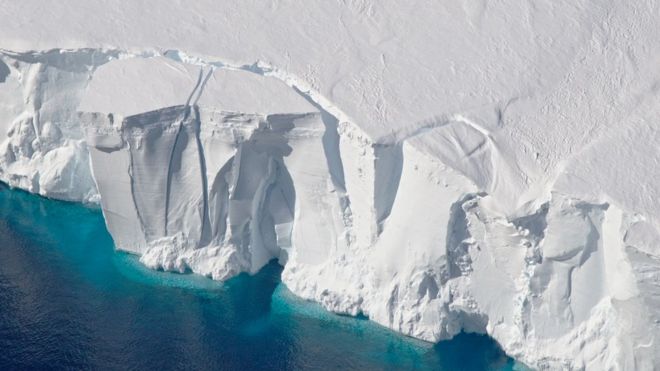Antarctica may be thousands of kilometres from the central Pacific but events there can have a significant effect on the White Continent’s ice.
A team of researchers has learned that the powerful 1997-98 El Niño event dramatically accelerated the melting of the ice shelves buttressing glaciers in West Antarctica’s Amundsen sea sector. The findings offer additional insight into the dynamics of this highly studied stretch of ice.
They also raise new questions about the future stability of West Antarctica’s massive coastal glaciers, which are currently shedding billions of tons of ice per year. Some climate models project more extreme El Niño events in the future, and one possibility the new work raises is that El Niño-driven thinning of ice shelves could push glaciers that were already weakened by climate change into a state of unstoppable collapse.
Lead study author Fernando Paolo, who conducted the research at the Scripps Institution of Oceanography and is currently based at NASA’s Jet Propulsion Laboratory, unearthed the 1997-98 El Niño’s outsized impact in West Antarctica while he was mining satellite records to look for short-term factors that impact the growth and thinning of ice shelves.
“[El Niño] came out while we were analyzing the data to see what we could learn about variability,” Paolo told Earther. “So we started digging in.”
El Niño is a recurring climate pattern defined by above-average ocean temperatures in the equatorial Pacific that affect weather patterns around the world, leading to a slight uptick in global temperatures. To tease out its impact on the West Antarctic ice sheet, Paolo and his colleagues looked at 23 years of satellite data collected by four European Space Agency-led satellite altimeters, which measure the height of ice shelves. The record, spanning 1994 to 2017, encompassed four El Niño events, including the two strongest ones on record, the 1997-98 and 2015-2016 El Niños.
After obtaining precise ice shelf height data, the researchers used a regional climate model to work out how much of the variability on a year-to-year basis was due to snowfall (which causes ice shelves to grow taller) versus ocean-driven melting (which causes ice shelves to thin from below).
The findings, published Monday in Nature Geoscience, reveal that the 1997-98 El Niño led to a substantial loss of mass from the bottom of the ice shelves in West Antarctica’s Amundsen sea sector, even as the shelves appeared to grow about ten inches taller from additional snowfall. Overall, ice shelves in the Amundsen sea sector lost about five times as much mass as they gained during the event.
According to Paolo, the changes can be explained by El Niño forcing a high pressure anomaly into the low-pressure system parked over the Amundsen sea, impacting wind patterns and driving more snowfall in West Antarctica. This change in the windfield also impacted ocean circulation, helping to pump warm, deep ocean currents to the surface, where they ate away at the ice from below.
The powerful 2015-2016 El Niño didn’t cause a similar loss of ice, leading Paolo to suspect that multiple climate conditions need to be met to trigger a major melt. He’s now gathering additional satellite data to extend the record further back in time and try to better understand the effect of short-term climate oscillations on these ice shelves.
Alison Banwell, a glaciologist at the Scott Polar Research Institute, University of Cambridge, who was not involved with the new research told Earther she found the study interesting, though “not necessarily surprising.”
“However, I am wondering whether surface melting was accounted for, and how significantly different surface melt rates were during El Nino years, compared to other years,” Banwell told Earther. “As in addition to basal melting [melting at the bottom of the ice shelf], surface melting is an important contributor to thinning rates, particularly during the summer months.”
Peter Neff, a glaciologist at the University of Washington who also wasn’t involved, said the new study was “impressive work” that “demonstrates what many have suspected for a while”—a connection between El Niño and the Amundsen sea coastline.
“The biggest question this brings to my mind is what role the 1940s El Niño had on Amundsen Sea coast glaciers,” Neff told Earther. “There are several published lines of evidence suggesting [the 1940s El Niño] could be the initial ‘bump’ that started the current ice loss in this region.”
That connection, between short term factors like El Niño and long term, large scale change in West Antarctica is especially important if we want to predict how this massive ice sheet will respond to human-driven warming.
“When we see a dramatic collapse or retreat, it was because the glacier was already in an unstable condition,” Paolo said. “And if they are in that state, any perturbation can [be the] trigger, like a big El Niño. Obviously, this is all hypothetical, but it makes perfect sense to think that way.”
El Niño alone won’t trigger an ice apocalypse—but when you combine it with human carbon pollution, it might just be the fracture that sets off the avalanche.















